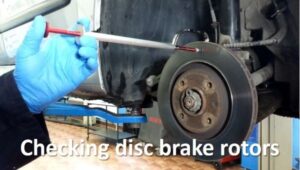Soldering iron
The soldering iron is used for melting easily soluble metal to connect metal parts, most often conductors. There is a soldering gun and soldering iron. Heat in a soldering iron is usually produced from electricity or butane-powered. Electric soldering irons are mostly used. The electric heater in the soldering iron heats the tip to the required temperature for melting the solder wire.
Soldering iron and soldering gun
Solder is a mixture of metals with low melting points and is used to join metals together. Tin-lead solder is used for soldering. Tin-lead solder for automotive applications consists of 60% tin and 40% lead and melts at approximately 190°C. With the environmental hazards of lead becoming an issue, it was introduced lead-free. Lead-free solder is made up of tin and copper, or of tin, copper, and silver. These alloys have a slightly higher melting point.
Solder creates good electrical contact between two conductors or joints in an electrical circuit. Before soldering, the electrical connection must be cleaned. It used an external flux cleaning agent of rosin. Flux help make the solder flow. The solder can also be hollow, with the rosin or acid in the core. In this case, it would be referred to as rosin-core solder or acid-core solder.
Solder wire and soldering flux
The process of soldering involves heating the metals (wires) hot enough so that the solder melts and fills the spaces between the metals. Soldering heat is provided by a soldering iron. The soldering iron has a handle that is thermally insulated. The tip of the soldering iron is heated, and the thermostat in the soldering iron controls the temperature. The soldering temperature is critical.
If it is not hot enough, the solder does not flow very well and does not make good contact with the metal surfaces, and tends to glob up. It is a cold solder. This makes for a weak joint and poor electrical conductivity.
If it is too hot, the solder tends to run off the joint and overheat the components being soldered. In the case of electronic components, overheating can make them inoperative. Only heat the components enough to melt the solder and cause it to flow, which can cause a short circuit to other electrical connections.
Soldering procedure and solder quality
Soldering procedure
Tin the soldering iron tip by melting some solder to it and wiping any excess from the tip with a rag. Apply flux to the joint if cored solder is not being used. Always remove any excess flux when finished. This may not be necessary if you are using cored solder. The tip of the soldering iron rests on the soldering spot. Apply the solder to the joint near the top. When the metal joint is well heated, the solder spills over the entire joint. When the solder spills, the soldering iron and solder are removed. Ensure the joint does not move until the solder has cooled sufficiently to set. Once cooled, inspect the joint; it should be shiny and firm. Clean any excess flux from the joint.








